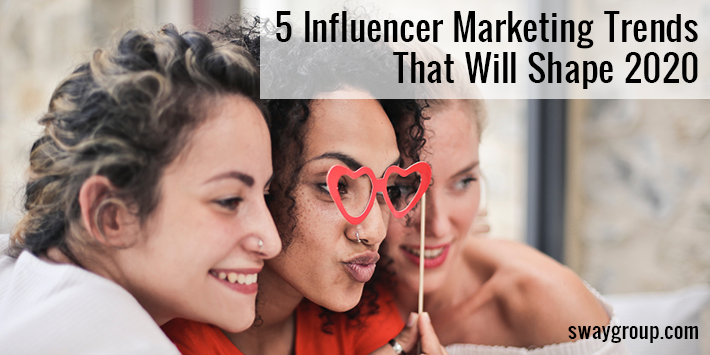In order to forecast the hottest influencer marketing trends in 2020, it’s important to take into account how influencer marketing has evolved in recent years. At Sway Group, we’ve been busy analyzing influencer campaign performance, platform changes, and brand preferences, in order to put together this list that was originally published on Forbes.

Our 5 predictions for influencer marketing trends in 2020
Here at Sway we’ve worked with some of the top brands over the years, along with thousands of talented influencers. The easiest prediction of all is that we’re going to continue to see a LOT of new opportunities in the business of partnering with online creators. Love it or hate it, influencer marketing isn’t going to disappear any time soon.
Within these areas of growth, however, we believe there are several influencer marketing trends and shifts that are coming our way. Let’s dive in!
Social Platforms: Instagram Reigns Supreme; TikTok is on the Rise
Instagram is going to continue its reign as the top performing platform for influencer engagement, with a growing emphasis on IGTV. Thanks to the relatively new feature of showing snippets from IGTV content within Instagram feeds with the option to click through for more, we’re changing our stance on IGTV from “Okay to ignore for now” to “It’s time for brands to experiment.”
Speaking of new things to try, we’re seeing engagement continuing to grow on Tik Tok. With 500 million active daily users, Tik Tok is a great place to reach the younger demographic, and we’re hoping they will soon open up their API so brands working with influencers can get first party data and the ability to provide valuable metrics.
While Twitter engagement isn’t as high as it used to be, don’t count them out just yet — with a major election year upon us, more users will be keeping track of news and commentary on Twitter.
Metrics Will Be More Important Than Ever
More and more marketers are looking for real ROI with influencer marketing, but it’s critical to look at the right metrics. With more information coming out of platform APIs, influencers and agencies are now able to see important engagements (like saves and private shares on Instagram) that aren’t visible to the public. These lower-profile data points can be incredibly useful for determining audience interest and new audience reach.
Metrics are necessary not only for evaluating the success of influencer marketing programs, but for justifying the growing trend of positions like the Chief Experience Officer. By partnering with agencies who have access to deep-dive influencer data, brands are better suited for optimizing their marketing efforts and driving consistent top-quality customer engagement.
Influencer Follower Size: Going Smaller for Big Results
My guess is that 2020 will be the year of the nano, from influencer size (IE, those with less than 10,000 followers) to podcast subscription size to laser-targeted small group marketing. With an approach that’s on the opposite end of the “spray and pray” scale, brands can reap the rewards of highly intentional content consumption.
Zeroing in on niches means getting to know your audience better than ever before: what they like, what their needs are, how they live. Brands who work with nano or microinfluencers have access to a more intimate creator/audience connection: the benefits here aren’t just about reachability and trust, but also the cost-effective opportunity to gain more knowledge about their target consumer.
In a nutshell, “fit over followers” will be the mantra of savvy brands in 2020.
Getting Real with Content
The popularity of visual-forward platforms has led to many dynamic, interactive visual trends, with next-level photo and video editing apps making professional quality imagery accessible to nearly everyone. While there will always be a market for aspirational content — those attractive idealized images that visually communicate in compelling ways — consumer demand for authenticity will drive more interest in raw, “behind-the-scenes” photos and video that showcase real life in all its sometimes-messy glory.
Instagram Stories and other ephemeral content platforms are ideal for users who want to keep their feeds populated with glossy, polished content but still have a place for the less-edited moments. This offers a place for brands to connect with audiences in a way that feels more relatable, and not so heavily stylized.
On a similar note, brands will need to be purposeful about choosing influencers from diverse populations and backgrounds. The era of the always-Caucasian, always-thin, always-blonde influencer showing off her latte foam art has (thankfully) mostly gone by the wayside. Audiences increasingly want to see content that reflects their own reality.
Combining Different Influencer Marketing Strategies for Maximum Impact
In 2020, we’re going to see brands relying on a mix of content strategies to really put some power behind their digital marketing. Influencer content will be combined with professionally-designed assets for branded imagery, infographics, social content, custom blog images, and more. Influencer content studios are likely to grow in popularity as an option for businesses who want the right kind of creative work without the overhead of a big agency or a full-fledged influencer campaign.
For brands who have historically outsourced all of their influencer work, or have handled it exclusively in-house, there will be a shift towards a hybrid model rather than an all-or-nothing situation. Agencies will need to have a flexible set of offerings, in order to provide everything from the full-service approach to filling in gaps to help with specific influencer tactics.
All in all, influencer marketing in 2020 is likely to be better than ever before. It’s going to be more targeted, more measurable, more transparent — and more effective. We can’t wait to see what brands and influencers bring to the table in the new year and beyond. Do you agree with these 2020 influencer marketing trends? We’d love to hear from you!
